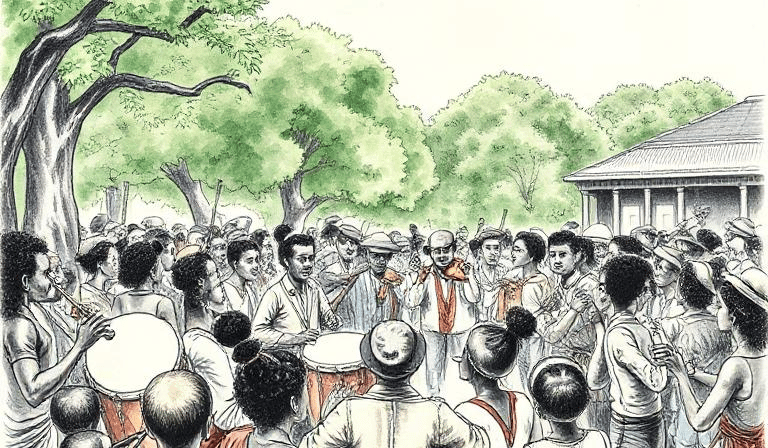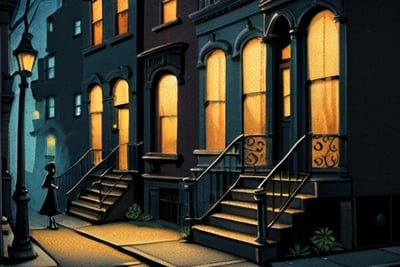The Origins of Jazz: The Story of Congo Square in New Orleans
Congo Square in New Orleans played a pivotal role in the birth of jazz, where African rhythms, European instruments, and American traditions converged. This blog explores the historical significance of Congo Square and its impact on the creation of jazz, one of America’s most iconic musical genres.
DipVai
1/31/20255 min read


New Orleans, a city known for its vibrant culture, rich history, and musical heritage, is widely regarded as the birthplace of jazz. But to understand how this genre emerged, one must look to a small patch of land in the heart of the city—Congo Square. Here, in the 18th and 19th centuries, enslaved Africans and free Black people gathered to preserve their traditions, exchange musical ideas, and create rhythms that would form the foundation of jazz.
Congo Square: A Sacred Space for Music and Culture
Congo Square, located in the Treme neighborhood of New Orleans, was once a part of the larger Place des Nègres. During the time of slavery in the United States, it served as one of the few spaces where enslaved Africans could freely express themselves. On Sundays, when enslaved people were given a rare day of rest, they gathered at Congo Square to drum, dance, and celebrate their African heritage.
At a time when African traditions were suppressed, Congo Square became a crucial outlet for maintaining cultural practices, especially through music. Drumming, dancing, and singing were central to African communities, and this public space provided a safe haven for the exchange of ideas and sounds. The music created here would later influence many American music genres, but none more so than jazz.
The Influence of African Rhythms
The music played in Congo Square was deeply rooted in the African rhythms and traditions that enslaved Africans brought with them to the Americas. The rhythms were complex, polyphonic, and interlocking, a reflection of the musical diversity of the African continent. African drumming traditions, including the use of call-and-response patterns and polyrhythms, laid the groundwork for the improvisational nature of jazz.
But Congo Square wasn’t just a place of African music—it was a melting pot of cultural exchange. Free Black people, Native Americans, and even European settlers came together at Congo Square to experience and contribute to this unique blend of music. The convergence of African rhythms with European instruments like the fiddle and guitar created a new, hybrid sound that would eventually evolve into jazz.
The Role of Brass Bands and European Influence
While Congo Square was primarily a site for African and Afro-Caribbean rhythms, the development of jazz also involved significant European influence. As New Orleans grew, brass bands became increasingly popular, and their incorporation into the music played in Congo Square helped shape the sound of early jazz. European instruments like the trumpet, clarinet, and trombone added new melodies and harmonies to the rhythmic foundation laid by African drumming.
This blend of African rhythm and European instrumentation was one of the defining features of New Orleans music. Over time, musicians began to experiment with improvisation, a hallmark of jazz, and started to develop a distinct musical language that would separate jazz from other genres of music. The vibrant, multicultural atmosphere of Congo Square played a crucial role in this process, providing a space where different musical traditions could merge and evolve.
The Birth of Jazz: A Fusion of Cultures
Jazz emerged in the early 20th century, but its roots can be traced directly to the musical activities that took place in Congo Square. The rhythm and improvisation that defined jazz were first nurtured in this sacred space, where African drumming and European instrumentation blended in creative ways. The music of Congo Square was not just an expression of cultural survival; it was the foundation of a new, uniquely American art form.
As the 20th century progressed, musicians like Louis Armstrong, Jelly Roll Morton, and King Oliver began to experiment with the sounds that had been born in Congo Square. Their innovations in improvisation, syncopation, and melody brought jazz to the forefront of American music. Jazz became a symbol of freedom, individuality, and artistic expression, and its origins in Congo Square were never forgotten.
Fun Facts About Congo Square and Jazz
The First Jazz Bands Played in Congo Square: The earliest New Orleans jazz bands performed in Congo Square, helping to develop the genre’s distinctive sound.
The Square Was Named After African Traditions: The name "Congo Square" is believed to have been inspired by the Congo region in Central Africa, where many enslaved Africans came from.
A Cultural Gathering Place: Besides music, Congo Square was also a place for social gatherings, where enslaved and free Black people could exchange news, ideas, and culture.
Influence on Other Music Genres: Jazz, born in Congo Square, influenced numerous other music genres, including blues, rock, and hip hop.
The Lasting Legacy of Congo Square
Today, Congo Square stands as a monument to the cultural contributions of African Americans and the birth of jazz. It is now part of Louis Armstrong Park in New Orleans, where it continues to attract visitors from around the world. The square serves as a reminder of the resilience and creativity of the African and African American communities who transformed their pain and struggle into one of the most influential musical genres in history.
Congo Square’s legacy is not just about music; it is about the preservation of culture, the blending of traditions, and the creation of something new from the old. Jazz, which originated in Congo Square, has had a profound impact on countless other genres of music, from blues to rock and roll to hip hop. It continues to shape and inspire musicians around the world.
Get in touch
itsusdipvai@gmail.com


















